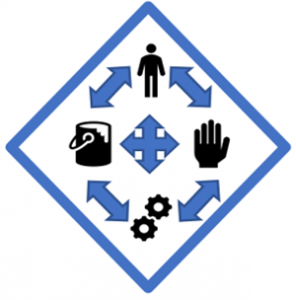Understand yourself and your team better – The cognitive diamant
Why is it important to understand ourselves and each other better in eSports?
The most important tool in esport is your head. It is the ability to understand yourself and others, that will ultimately be the key for you to succeed as an eSports athlete. It is also the key for you to succeed as a team. Therefore, it is alfa and omega that we practice the ability to understand our own psychology – what happens on the inside of your head.
Basically, we are all the same, behind the eyes. We all think, feel, have bodily reactions and we all have behavior. All these things happen constantly, every day. Because we all basically function in the same way, we can practice getting better at understanding ourselves and each other, by using the right psychological tools.
Psychology is the science of “mind and behavior”. That means psychology can be used in esports to make us more aware of what is going on within ourselves. It also means that we can use that knowledge to understand the behavior we are all carrying out. This gives us the chance to master ourselves and understand others around us better. That is why this is our motto when working with esports athletes and teams:
Master the player
Master the game
In this aritcle you will learn about the cognitive diamond, and how we use this tool to understand ourselves and each other better. The last part of the article will feature concrete examples on how we use this in real life.
A tool to understanding yourself and others: The cognitive diamond.
To understand how our minds work, psychologists have worked with the term cognition for decades. Cognition means “the ability to learn and understand new and old knowledge through mental actions or processes and the experience of thoughts and sensory imputs.” That is a very fancy way of saying that cognition is the way we experience the world through thoughts, feelings, bodily reactions and behavior.
To translate our cognition into a useful tool, we use the cognitive diamond.
What is it?
The kognitive diamond is a model that is used to make it easily understandable how our inner life is structured. It is put into this model:
At the top we have bodily reaction (the body), to the left we have emotions (emotions “paint our experience, therefore the paint bucket), to the right vi have behavior (the hand) and at the bottom we have thoughts (the cogs of cognition).
The arrows between the four parts of the diamond show the relation between all its parts. They all constantly affect other. You can try and experiment to realize this right now: Try noticing what you are thinking about right now. Does it match how you feel? Does it match your bodily state? Does it match the way you are behaving right now? Most likely it does. Right now you are reading, which means your thoughts are guided by what you read. Your emotions are most likely calm and mellow. You bodily state is most likely calm as well, as you are sitting relaxed. Your behavior; reading, is also calm and relaxed. But if you stand up and do 20 squats right now, you bodily state would change (breathing accelerates, pulse intensifies). This would affect the rest of your cognitive system.
We use the following definitions of the four parts of the cognitive diamond in this article:
- Bodily reaction: The reactions that you can feel happening in your body; heartrate, pain, breathing, chills, hot and cold, and everything else that happens without your control.
- Emotions: The inner signaling system. This system paints your experience. We all know them: Anger, joy, sadness, surprise, fear, contempt and disgust.
- Behavior: The things that we do. Speaking, moving, laughing, etc. Think of behavior as something that is visible to others. Thoughts and feelings are not visible to others, but smiles and tears are.
- Thoughts: The inner experience we have. It can be the “inner voice”, mental images or sounds. Thoughts are the way we process our experiences within ourselves. We all have them constantly, and they are the key to our distinction from just being animal; they help us foresee and plan the future, understand the past and experience the now.
Why should we use the cognitive diamond in esports?
The cognitive diamond is interesting to use in esport because we must constantly use our head to be excellent in esports. Not just to master the game we play, but also to master how to understand ourselves and our teammembers.
Just imagine playing with someone who were completely controlled by their emotions. Everything things were going great, they would be completely happy and without a care in the world. The next moment, when things turned bad, they would be crying, rolling around of the floor. Just like a kid. And that is an important part of why we should practice using the cognitive diamond: It gives us the change to understand how our thoughts, feelings, bodily reactions and behavior affects each other. Thereby we can better target the factors we need to work on to not end up behaving like a kid.
How do we use this tool?
Just as with any other tool, it takes time to practice the cognitive diamond. If we compare it to a saw it might become easier to understand: In order to use a saw properly you have to learn how to grip it, how to angle it, how to pull it with the right amount of force, how to keep it straight, and so on. If you just use brute force, the saw will constantly bend, and you will be sweating in no time.
First step: Awareness
With the cognitive diamond we also need to practice one thing a time, and not “force it”. The first step in using it is simply to realize how your own mind works. You can practice it right now: write down what you are feeling, thinking, experiencing in your body and what you are doing right now. Set at timer for 5 minutes. Start playing your esport. Every 5 minutes, write down your current emotion, thoughts, experiences and behavior.
Practicing the awareness of your own mind and behavior is an essential key to understanding yourself better. It is also a very good tool to overcoming tilt. Write down you cognitive state with the 4 factors when you tilt. You will soon realize that your emotions affect your thinking, your thinking affects your emotions, your emotions affect your bodily reactions, which affect your behavior, which affects your emotions, which affect… and so on and so forth.
Second step: teamwork
As promised in the beginning, this is not just a tool to understand yourself. It is also a tool to understand the people around you. Therefore, this second step is all about someone else.
Try talking to your teammate or you coach about the cognitive diamond. If they do not know it yet, show them! When you both understand it, try analyzing a situation you have both experienced, such a winning a game, losing a game, tilting or even how you feel when being criticized. Talk about how it affects your cognition, and how you can use the cognitive diamond to handle that situation even better next time.
Third step: take control of yourself
This last step of learning to use the cognitive diamond in esport is very simple, but extremely hard to do. Next time you are in a situation where you have a behavior that you do not want to, use the diamond to understand why you are doing so, and then how you can stop it. An example is tilting. Nobody WANTS to tilt, but we all do it. Next time you do, analyze why you do so. Then analyze what you should do to stop it. Keep following us if you want to learn great ways of overcoming your own non-wanted behavior.
Examples of how the cognitive diamond can help
This is four short examples of how the cognitive diamond can help you as an esports athlete.
You made a mistake
Imagine that you made a fatal mistake in game, which made your opponent get the upper hand. Now you are struggling to get back. This will give you some sort of emotion, some thoughts, a bodily reaction and it will affect your behavior. It is time to become aware of yourself. Are you extremely frustrated? Does this frustration make you think that you must do something crazy to get back into the game? Does your stomach twist and turn with this frustration?
Become aware of your cognitive factors. Now try using them to get back on track. Do not think about crazy things but think about what you now from your training. What do you have to do, to buy the right items, play the right pass or position yourself in right angle? You already know this, and you can easily analyze your way to would you SHOULD do. Now do it, even though your emotions and bodily reaction is frustrated. And notice how they are slowly but surely getting more relaxed again. If you succeed with the tactic you know you should use, the frustration will disappear altogether.
Your teammate made a mistake
Now you have worked on what to do when you make a mistake yourself, it is time to work on how you can help your teammate.
Image that you are playing an important qualifier, and suddenly one of your teammates positions themselves wrongly. This gives the other team a chance to kill him off quickly, leaving you with a disadvantage for the rest of the round. Your teammate is visu
ally annoyed.
It is very hard to help someone with their cognitive experience if you are playing the game right now. Therefore, the best way to help your teammates, is to use your next team meeting to talk about what happened in that situation. Use the cognitive diamond to go over what thoughts, emotions and bodily reactions he had when he made the mistake. It is not surely that you can analyze your way to understanding exactly what happened, but the talk can help you and your teammates to get a better understanding of what happened and thereby how you can better avoid it in the future.
NOTE! When talking about other people’s mistakes, it is important to be respectful and make sure they understand you are not attacking them personally. Tell them that you are all trying to learn what happened, so you can help each other better as a team the next time the situation arises. The cognitive diamond can be a good tool to help you make it something objective you talk about, rather than the team members fault (yes, it was his fault but has anyone ever become better by being told they are failures?).
It takes practice.
If you are serious about creating a succesful career for yourself in gaming it is without question important for you to learn how to work on yourself and the people around you. Keep following our updates to learn more about how you can utilize psychology to learn more about the people in your esports career.


